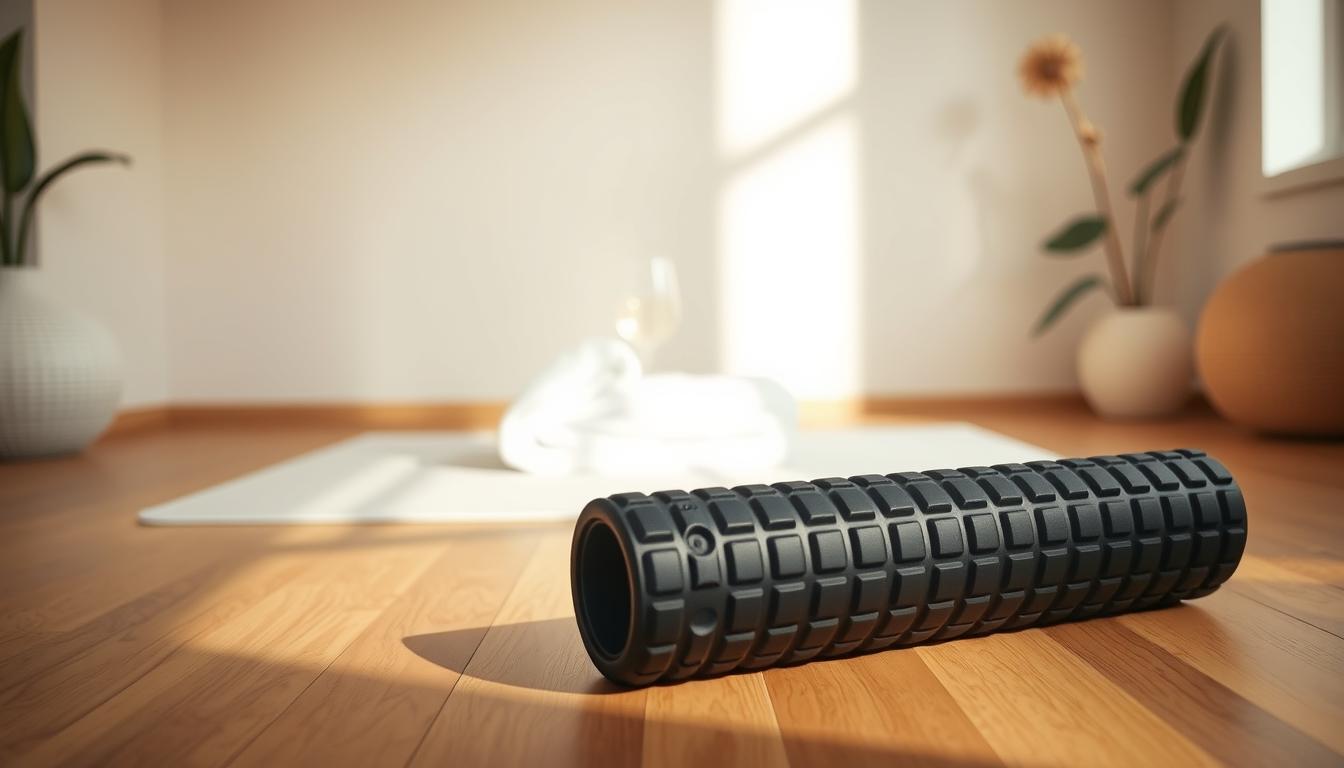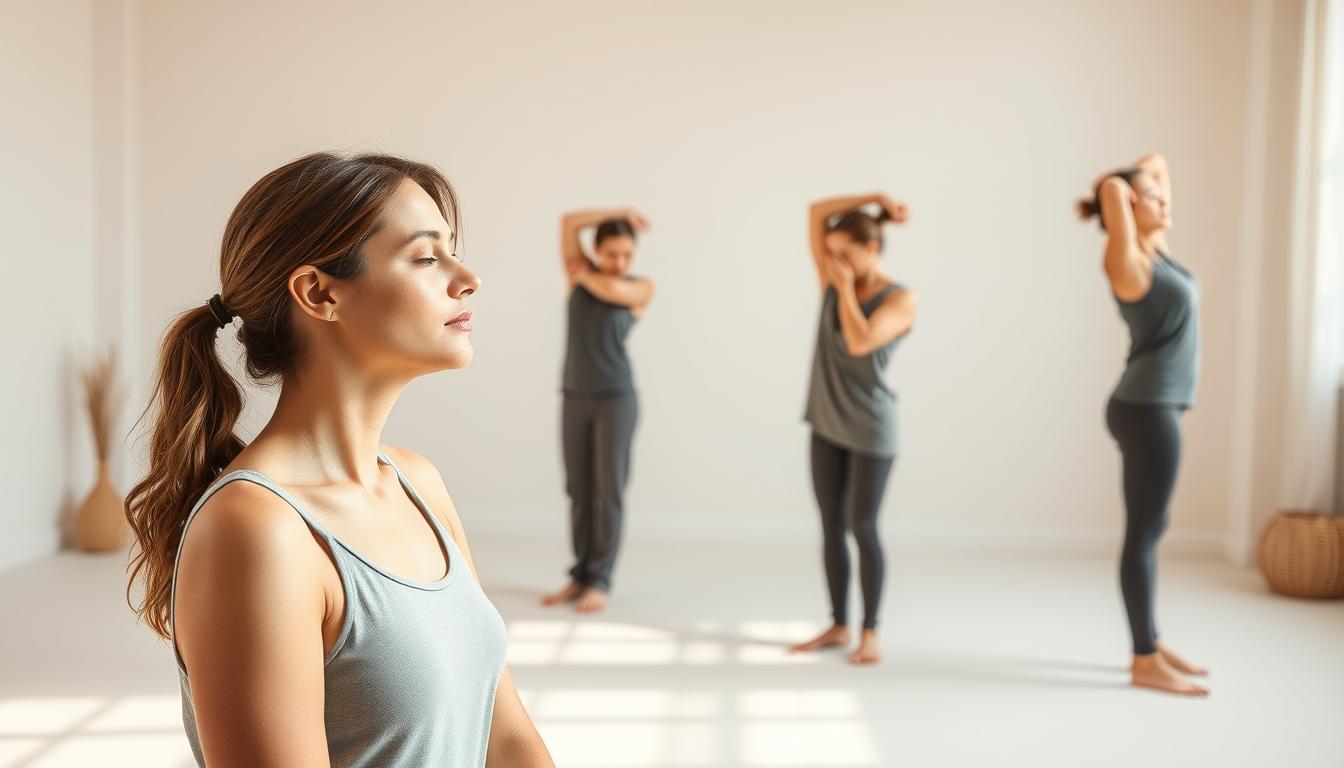Are you tired of the constant neck pain? This guide offers effective exercises for neck pain relief. Knowing the neck’s structure helps identify common pain causes. It guides relief practices. By adding easy stretches or advanced strengthening exercises to your daily life, you can improve greatly. Start this journey to a pain-free neck and see how regular practice changes everything.
Understanding Neck Anatomy
Knowing the basics of neck anatomy is key to easing pain. The neck has seven cervical vertebrae, forming the cervical spine. This spine is held up by a complex mix of muscles, tendons, and ligaments. Important muscles include the sternocleidomastoid, trapezius, and levator scapulae. These muscles are essential for neck movement and keeping the head stable.
Together, these parts allow the neck to move in different ways, like turning and bending. They also help absorb impacts and spread out the head’s weight. Understanding neck anatomy helps people focus their exercises to reduce pain and improve movement. This knowledge lets them target the right areas for better neck health.
Common Causes of Neck Pain
Neck pain comes from many sources that change daily life and health. Knowing the reasons helps in finding the right treatments and prevention. Main causes are bad posture, muscle strain, and aging-related issues.
Poor Posture
Bad posture plays a big role in neck pain but is often ignored. People who look down at screens or sit poorly for hours are at risk. This puts stress on the neck’s bones, causing pain over time.
Muscle Strain
Muscle strain is a big cause of neck pain too. Doing the same motion over and over or twisting suddenly can hurt neck muscles. Spotting muscle strain early is key to stop more harm and ease pain.
Degenerative Conditions
Conditions like osteoarthritis or herniated discs cause lasting neck pain. These get worse as people get older, making the neck stiff and sore. Knowing about these issues helps in finding ways to cope and adjust.
Benefits of Neck Exercises
Doing neck exercises regularly brings many good things. They make you more flexible, helping you move better overall. Plus, they build muscle strength for everyday jobs. Best of all, they help lessen pain, making daily tasks easier.
Improved Flexibility
Adding neck exercises to your day boosts flexibility. This means you can move your head easier and with less tightness. It makes life more comfy, especially when you need to look around or up.
Enhanced Muscle Strength
Neck exercises are key for stronger muscles. This strength keeps your posture right and stops you from getting tired when you sit or play sports for a long time. It also helps avoid injuries, keeping you safe as you move.
Pain Reduction
Pain relief is a big plus of neck exercises. Doing them often cuts down on tension and soreness. When you get stronger and more agile, neck pain often drops, making everyday life smoother.
Preparing for Neck Exercises
Before starting neck exercises, it’s important to get ready properly. This starting phase helps make sure your workout is safe and works well. Warming up, being safe, and right breathing make the whole experience better and more effective.
Warm-Up Techniques
Gentle warm-up methods are key to prepare your neck muscles. They also help increase blood flow. Here are some ways to get ready for neck exercises:
- Neck rotations: Slowly rotate your head in circles to ease tension.
- Arm circles: Stretch your arms out and make small to big circles.
- Shoulder shrugs: Raise your shoulders up, hold, then let them down.
Safety Precautions
Keeping safe while doing neck exercises is very important. Always follow these safety tips:
- Avoid overstretching: Pay attention to your body to avoid getting hurt.
- Maintain good posture: Keep your back straight and your shoulders relaxed.
- Be mindful of discomfort: If it hurts, stop and check your form.
Proper Breathing Methods
Using the right breathing techniques can make your routine more effective. Keep these tips in mind:
- Breathe deeply and slowly: This ensures your muscles get enough oxygen.
- Inhale during preparation: Take a deep breath before you move.
- Exhale during exertion: Let out your breath to relax with each move.
Basic Neck Stretches
Doing basic neck stretches is key for easing neck pain. Adding these easy exercises to your day helps make your neck more flexible and less tense. Here are a few simple neck stretches to try:
- Forward Neck Flexion: Gently lower your chin towards your chest and hold the position for a few seconds. This stretch helps alleviate pressure at the back of the neck.
- Side Neck Stretch: Tilt your head towards one shoulder and hold for several seconds, then switch to the other side. This stretch targets the sides of the neck and aids in relieving stiffness.
- Upper Trapezius Stretch: Sit or stand comfortably and reach one arm across your body while tilting your head to the opposite side. This stretch focuses on the muscle at the top of your shoulders and neck.
You can do these neck exercises while sitting or standing, which makes them easy to do any time. Doing these stretches often can really help with neck pain and make you feel more comfortable.
Advanced Neck Stretches
Adding advanced neck stretches to your daily habits can really ease chronic neck pain. These special stretches focus on reducing pain and bettering neck movement and comfort. Here are a few techniques to try.
Levator Scapulae Stretch
This stretch targets the muscles that lift your shoulder blade, easing neck tightness and tension. It makes moving your neck easier. To do it, sit down, lean your head towards a shoulder, and look down. You should hold this for 15-30 seconds, feeling the stretch on your neck’s side.
Scalene Stretch
This stretch aims at the neck’s side muscles, which can get tight from bad posture or stress. Turn your head to the side and gently extend your neck upwards. Hold this pose for 15-30 seconds before switching to the other side. This helps lessen tension and boosts neck flexibility.
Neck Retraction Stretch
The neck retraction stretch is key for fixing your posture and aligning your spine. It’s done by pulling your head back while your chin stays tucked. This exercise is great for people who work at desks or use screens a lot. Keep the stretch for 15-30 seconds, focusing on your neck’s back stretching out.
Strengthening Exercises for the Neck
Doing exercises for your neck is really important. It can help with neck pain and make your neck stronger. Exercises like neck isometrics, head lifts, and shoulder blade squeezes can make your muscles stronger and help your posture.
Neck Isometrics
Neck isometrics are about making your neck muscles strong without moving them. This is a safe way to get stronger for people at any fitness level. Here’s how you do it:
- Place your hand against your forehead.
- Apply gentle pressure, resisting movement for 5 to 10 seconds.
- Repeat this process using the sides and back of your head.
Head Lifts
Head lifts work the muscles in your neck. They help with stability and keeping everything aligned. Here’s how to do head lifts:
- Lie on your back with your knees bent.
- Gently lift your head off the ground, holding for a few seconds.
- Lower your head back down slowly, ensuring controlled movements.
- Perform 10 to 15 repetitions.
Shoulder Blade Squeeze
The shoulder blade squeeze is great for your upper back. It helps hold your posture right and lessens neck strain. To do this exercise:
- Sit or stand up straight.
- Pull your shoulder blades back and together.
- Hold for 5 seconds, then relax.
- Repeat this 10 to 12 times.
Posture Improvement Techniques
Making your posture better is key to stopping neck pain. It involves changing your workspace to be more comfortable and supportive. One good change is to make sure your monitor is at eye level. This stops you from having to look down too much.
Having your chair at the right height is also important. This means your feet can rest flat on the floor, which helps you sit straight.
Taking short breaks when you sit for a long time is helpful. Standing or walking for a bit not only clears your mind but also loosens tight muscles.
Doing exercises that make your core and back muscles stronger helps a lot with posture. A strong spine is under less stress. Adding stretches that make your chest wider and upper back stronger will also improve your posture.
Aerobic Exercises for Neck Health
Adding aerobic exercises to your workout helps your neck stay healthy. Walking, swimming, and biking boost your heart health and increase blood flow. This improved circulation is key for muscle recovery and reduces neck tension.
Staying active with regular aerobic exercise prevents your neck from getting stiff and sore. This way, you can keep your neck healthy and avoid long-term pain. Doing these exercises every day improves muscle function and overall health.
Ergonomic Tips for Neck Pain Prevention
To help prevent neck pain, it’s key to focus on ergonomics, especially at work. Make sure your workstation helps you keep a good posture. Adjust your chair, desk, and computer screen so your spine stays neutral.
This setup helps avoid neck strain and keeps you comfortable during work. Here are some extra tips:
- Set the monitor at eye level to avoid straining your neck.
- Choose a chair that supports your neck and back well.
- Place items you use a lot within easy reach.
- Remember to take breaks for standing, stretching, and keeping blood flowing.
Good sleep habits are also vital for preventing neck pain. Use a pillow that keeps your spine straight for better sleep. Try to cut down on using your phone or tablet for too long. Holding these devices at eye level is a smart move for your neck.
When to See a Professional
Knowing when to get help for neck pain is crucial. Sometimes, neck pain can be severe and might suggest serious problems that need quick action. It’s important to watch your symptoms to see if simple home treatments work or if you should see a doctor.
Identifying Severe Symptoms
Being aware of serious neck pain signs is key in deciding when to visit a doctor. Watch for:
- Persistent pain that rest or basic meds can’t fix.
- Numbness or tingling in your arms or hands.
- Muscle weakness in your arms or hands.
- Hard time moving your head or neck.
Understanding When Exercise Isn’t Enough
Exercises at home can help ease neck pain. But sometimes, you need a doctor’s opinion. If your pain doesn’t go away or gets worse, get help. Ignoring it might make things harder to fix later.
Types of Specialists to Consult
If you need better help with neck problems, think about seeing:
- Physiotherapists for exercises and healing plans.
- Orthopedic specialists for bone and muscle issues.
- Chiropractors for spine adjustments.
Lifestyle Changes for Neck Health
Making effective lifestyle changes is key to keeping your neck healthy. Doing regular physical activity makes muscles stronger and more flexible. This can greatly lessen discomfort. Adding various exercises, like aerobics and strength training, keeps the neck and nearby muscles in tip-top shape.
Along with working out, eating a balanced diet full of important nutrients helps repair muscles and boosts overall health. Foods rich in protein, omega-3 fatty acids, and vitamins keep muscles strong and cut down on swelling. Sticking to dietary recommendations gives your body the right support for a healthy neck.
Managing stress also plays a big part in neck health. Activities like yoga and meditation lower tension and reduce neck pain caused by stress. These lifestyle changes not only make you healthier but also improve your well-being.

The Ultimate Neck Pain Relief Exercise Guide
To tackle neck pain, it’s key to know the right exercises. This guide highlights stretches and strength-building moves to lessen pain and enhance neck health.
Try adding these exercises to your daily plan to boost neck movement and decrease pain:
- Gentle neck stretches: Do side bends and turns often to improve flexibility.
- Strengthening workouts: Try isometric exercises to strengthen neck muscles.
- Regular breaks: Take short breaks during work or while on devices to lower strain.
Making these habits regular can really help with neck pain and keep your neck healthy. Putting in the effort to both stretch and strengthen will bring results.
Conclusion
Managing neck pain well means being proactive. It’s important to focus on exercises, improving how you sit and stand, and changing your lifestyle. By following a detailed neck exercise plan, you can ease your pain and feel better overall. Simple exercises done regularly, like stretching and strengthening, can greatly help with lasting relief.
Listening to what your body tells you during this time is key. Knowing when to change your exercises or when to get help from a doctor matters a lot for dealing with neck pain. Since everyone’s body is different, you might need a plan that’s specifically made for you to get the best results.
Getting rid of neck pain takes time. Sticking to your exercises, paying attention to how you sit, and making good lifestyle choices are all part of recovering successfully. Take this journey one step at a time and stay focused on being healthy. This dedication is what will help you live a more comfortable and happy life.



